Posted by Anita on 11.02.08 8:48 PM
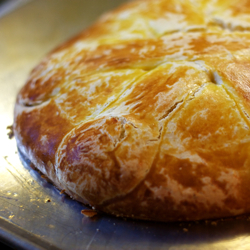 I must be getting old, because I actually just said out loud: “Where has the year gone?” Really, people, can I get an amen here? Doesn’t it seem like 2008 has just screamed on by? (And yet, somehow, Election Day seems like it might never come.) I don’t want to get ahead of myself, but the holidays are really right around the corner, with Halloween just past and everyone’s favorite feast less than a month away. And today’s a holiday, too: Dia de los Muertos.
I must be getting old, because I actually just said out loud: “Where has the year gone?” Really, people, can I get an amen here? Doesn’t it seem like 2008 has just screamed on by? (And yet, somehow, Election Day seems like it might never come.) I don’t want to get ahead of myself, but the holidays are really right around the corner, with Halloween just past and everyone’s favorite feast less than a month away. And today’s a holiday, too: Dia de los Muertos.
I feel like I’m repeating myself a little here — we talked about marigolds, sugar skulls, and La Catrina last year. But really, there’s so much more to enjoy, so many more wonderful food traditions that go along with this fiesta. After all, the idea behind the Dia de los Muertos ofrendas — the memorial altars to loved ones — is that the living tempt the spirits of loved ones to pay a visit by putting out their favorite foods, drinks, and other little mementos of the things they loved in life.
Last year, I took a day off from work and brought home a whole table’s worth of treats. This year, the weekend snuck up on me; the best I could manage was relocating a flowering houseplant (not quite marigolds, but hey, at least they’re orange), and adding a few things I know my Dad loved: A jar of home-made tomatillo salsa, a shaker of Tabasco-flavored seasoning salt, and the little greyhound calaca figurine — Dad would never travel anywhere without his dogs.
Almost as much as he loved greyhounds and spicy food, Dad loved sweets. I knew the ofrenda couldn’t do without pan de muertos, the rich, eggy bread made just for the occasion. But I had no time to head to the Mission, and with Eat Local Challenge just wrapping up it didn’t seem right to buy a loaf filled with goodness knows what.
My first attempt at homemade pan de muertos was a qualified success; tasty, but flawed. I can almost hear Dad telling me, as he always did, that I am being too critical of my own efforts: “Neen, it looks great. I don’t know what you’re talking about.” (And he’d be right… it really does look fine, just not like I expected, and definitely not like store-bought.)
The nice thing about pan de muertos — and all of the tempting treats laid out on the ofrendas — is that they’re just as much for the living as for the deceased. Hooray, we get to eat it, too! And even though I know that the holiday is supposed to be filled with happiness and fond memories, this year I’m happy to have a little extra bit of comfort to help me get in the festive mood.
You see, this year we’re also remembering our friend Briana Brownlow in our celebrations. Bri passed away just last week, at the impossibly young age of 31, after a hard-fought battle against cancer. Though we met her in person only once, we knew her well as one of those people who makes everyone’s life online a little brighter. Even in the midst of her cancer’s recurrence, it was a joy to see Bri’s optimism, and her obvious joy as friends offered support through food (and a food-bloggers’ fundraiser).
Tomorrow morning, when I toast up a piece of the leftover pan — looking out at the bright yellow of our lemon tree in the otherwise grey, rainy yard — I’ll smear it with some of the citrus curd I made from our backyard fruit and remember the woman whose strength inspired so many.





Alas, no recipe today. I’d planned to share my variation on Diana Kennedy’s pan de muertos, but something went awry. Not badly enough to keep us from eating the bread, but odd enough to keep me from unleashing the recipe on you. The “bones” melted into the main body of the bread, and the whole thing came out far too flat and wide; I think I must have miscounted egg yolks or mis-measured butter. It still tastes fabulous, though… it just doesn’t really look the way it ought.
But don’t let that discourage you from giving it a whirl. Although it’s a time-consuming recipe that calls for fussy things like overnight rises in the fridge and multiple buttered sheets of waxed paper, it’s a very forgiving dough that’s a lot of fun to make.
baking, family, holidays & occasions, Mexican, other blogs
1 Comment »




Posted by Anita on 05.04.08 11:30 PM
 Â A few years ago on May 5, I found myself in Puebla — the city where the historic Cinco de Mayo victory of Mexican forces over their French invaders took place. When I asked my taxi driver if there were any festivities planned to commemorate the anniversary, he looked at me like I was crazy: “It’s a military holiday, mija.”
 A few years ago on May 5, I found myself in Puebla — the city where the historic Cinco de Mayo victory of Mexican forces over their French invaders took place. When I asked my taxi driver if there were any festivities planned to commemorate the anniversary, he looked at me like I was crazy: “It’s a military holiday, mija.”
Even in Puebla, the idea of Cinco de Mayo as an event worthy of feasting and celebration seemed utterly unknown. Every Poblano who I told of the norteamericano version of the holiday — at best a celebration of Mexican-American pride, at worst an excuse to drink excessive quantities of nasty sour-mix Margaritas — expressed complete astonishment, shaking their heads as though they’d just discovered yet another reason to pity our confused country.
But no matter: I hadn’t gone to Puebla in search of patriotic parades or folklorico dancing in the city squares. I’d gone there to spend a few days relaxing before meeting friends in the bustle of Mexico City, to explore the city’s beautiful colonial architecture, and to eat Puebla’s famously delicious food.
Strolling the streets the morning of my arrival, I found a peasant woman standing in a tiny off-the-path plaza, selling tamales out of a steaming metal can. There were three choices, but I barely registered the first two: The last, the one I chose, was mole. There are many moles in Mexico of course, but the best-known — the chocolate-tinged, brick-red one most Americans think of when they think of mole — hails from Puebla. Reputedly invented by an order of nuns in honor of their bishop’s visit, mole poblano is sinfully delicious and worth every bit of the hassle it takes to make it. It also makes an excellent tamale filling, a perfect breakfast after 12 hours of travel by plane and bus and taxi.
Thus fortified, I wandered Puebla’s tidy grid of streets without much of a plan. I explored the cathedral of the angels, considered one of the country’s most stunning churches, followed by a plate of tacos árabes at a tile-bright shop called Tacos Tony. I watched the propane vendors ply their wares: Pulling their truck up to the middle of a residential block, they blared their promotional jingle — a festive snippet of dance music, punctuated by a deep bass voice crying “EL GAZ!!” — and the ladies of the house would come to the street bearing tanks to be filled. On my way to the Mercado Carranza, I stumbled across a Victorian-era shopping arcade featuring an enormous stained-glass gazebo and cobblestone footpaths. And once I reached the mercado, I discovered my favorite Puebla snack: Cemitas, at a stand called El As de Oros.
Some folks will tell you that a cemita is little more than a torta served on a Puebla-style roll rather than a more typical bolillo, but the differences run a little deeper. Like tortas, cemitas are available with the diner’s choice of meat fillings — stew-like tinga, crispy carnitas, chewy cueritos, or golden-brown milanesa. And like tortas, cemitas are essentially a taco on a bun.
Unlike a torta, though, you rarely see mayonnaise on a cemita, nor frijoles; lettuce is a definite no-no. Aside from the meat, toppings nearly always include a generous amount of avocado, a bouncy cheese like panela or queso de Oaxaca, a slather of salsa roja, and a pungent herb called papalo. Like tacos árabes, cemitas have their roots in the cuisine of Puebla’s Lebanese immigrants. The word itself means “semite”, a nod to the soft, eggy, sesame-seeded rolls borrowed from the Arabic kitchen.
Alas, unlike in Los Angeles — where a gaggle of cemita trucks are giving their taco-vending cousins a serious run for the money — you’d be hard pressed to find a cemita for sale in San Francisco. But of all the comidas tÃpicas poblanas, cemitas are the easiest to make. Even if you quake at the thought of a day-long adventure required to make authentic mole poblano, or the near-impossible task of replicating spit-grilled tacos árabes at home, cemitas are a cinch.
The ones we’re enjoying as our Cinco de Mayo treat are filled with the homemade chicken-fried-steak called milanesa, arguably the most-popular cemita filling. But if you’ve got some carnitas or tinga left over from your own festivities, I guarantee they’ll find a happy home between two halves of a sesame-seed bun.





Cemitas Poblanas de Milanesa
1 pound beef sirloin tips, pounded thin
1/2 cup flour, seasoned with 2tsp salt and 1tsp pepper
1 egg, well scrambled with 1T water
1/2 cup fine breadcrumbs
oil for frying
—–
4 challah rolls, preferrably sesame seeded
1 mild white or red onion, sliced thickly
8 oz panela or queso de Oaxaca, or other fresh and creamy Mexican cheese
your favorite mexican salsa roja (the cooked smooth sort, not like pico de gallo)
– or substitute a few pureed chiles chipotles en adobo thinned with water or vinegar
2 large avocados, peeled and sliced
16 sprigs of papalo (or substitute cilantro)
Pound the meat flat with a meat tenderizer, 1/4-inch or thinner, and pat dry with a paper towel. If the pieces are larger than sandwich size, you may want to cut them apart. Dredge the meat in the seasoned flour, brushing off any excess until just the thinnest layer remains. Dip quickly in the egg, again taking care to leave as little as possible on the meat, and then a light layer of breadcrumbs.
In a deep skillet, add sufficient oil to shallow-fry at a depth of 1/4 inch. (In my 10-inch skillet, I used about 3/4 cup.) Heat the pan over medium heat until oil is shimmering but not smoking. Place the breaded meat in the pan and fry until golden brown on both sides, just a few minutes total. Remove from the pan and keep warm on a cooling rack in a warm oven.
Cut the buns in half, and lightly toast under a broiler or on a griddle. While buns are toasting, coarsely smash 1/3 of the avocado in a bowl with the back of a fork. Spread the mashed avocado on the bottom of each bun, and season with salt. Pour the salsa onto a small saucer, and dip the top half of each bun into the salsa to coat; set aside. Top the bottom half of the bun with a piece of the milanesa, followed by cheese, onions, papalo or cilantro, and the remaining sliced avocados, and the salsa-smeared top.
Something to drink?
– Margaritas: Drink of the Week 9/15/06
– Michelada: Drink of the Week 11/24/06
– Sangrita: Drink of the Week 6/1/07
holidays & occasions, meat, Mexican, travel
3 Comments »




Posted by a Special Guest on 03.28.08 7:03 AM
 Editor’s note: Our pal Sean returns once again to Drink of the Week guest-bartender duties with a delicious, prettily pink cocktail inspired by the fabulous girl in his life.
Editor’s note: Our pal Sean returns once again to Drink of the Week guest-bartender duties with a delicious, prettily pink cocktail inspired by the fabulous girl in his life.
—-
Last week, we celebrated one lunar year with our daughter dog, Reese. Like proper San Franciscans, we simply had to throw a cocktail party to, um, mark the occasion. But what to serve? Salty dog? Perhaps. Bark-tini? Ugh, no. Greyhound? Now we’re talking.
Nothing more than vodka and grapefruit juice, the Greyhound can be lovely with brunch, but it’s maybe not the most interesting option for cocktail hour. Luckily, we had just finished our inaugural batch of pompelmocello, and so we decided to sub that in for some of the vodka. And being cunning linguists as we are, we dubbed our newfound concoction the Italian Greyhound.
The name was apt, for when we were researching breeds while ‘shopping’ for a dog, Italian Greyhounds were front-runners in our consideration. Apartment-sized, trainable and loving, they seemed like a good match for us. The one deterrent was that they have a tendency to burrow under blankets and pillows, and if you accidentally and unknowingly sit on one in its ersatz lair, you can kill it. Maybe, we thought, we wanted something a little sturdier. In the end, we got our Manchester Terrier mix pound puppy, who at 17 pounds swaggers with the attitude of a dog many times her size.
Alas, there already exists a cocktail called the Italian Greyhound, basically your standard Greyhound with a float of Campari on top. It’s just as well, for in tinkering with the recipe further, I decided vodka wasn’t really the way to go anyhow. In order to convert the greyhound into something worthy of a cocktail glass, I had to bump up the booze-to-juice ratio, and vodka just wasn’t bringing anything to the party. Gin, on the other hand, offered enough complexity to offset the acidity of the juice.
All that remained from the original inspiration was grapefruit juice, and smaller amounts of it, but I still wanted to honor its provenance. Anita suggested dubbing it the Levriero — Italian for greyhound — and so a new cocktail was fledged.





Levriero
1 oz limoncello (or pompelmocello)
1 oz gin
2 oz red grapefruit juice
Shake with ice and strain into a chilled cocktail glass. Garnish with mint sprig or a twist.
Drink of the Week, drinks, holidays & occasions, preserving & infusing
6 Comments »




Posted by Anita on 03.20.08 11:44 PM
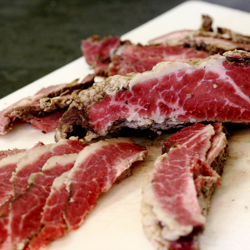 If you ask Cameron what his favorite cold-weather meal is, you might be in for a surprise. It’s not Thanksgiving turkey with all the trimmings. It’s not even a big prime rib, with plenty of leftovers for his beloved beef-and-bleu sandwiches. No, the thing my Scots-Irish husband loves best when the nights are long is New England Boiled Dinner — better known as “corned beef and cabbage” — with a hearty dollop of horseradish cream and an imperial pint of stout to wash it down.
If you ask Cameron what his favorite cold-weather meal is, you might be in for a surprise. It’s not Thanksgiving turkey with all the trimmings. It’s not even a big prime rib, with plenty of leftovers for his beloved beef-and-bleu sandwiches. No, the thing my Scots-Irish husband loves best when the nights are long is New England Boiled Dinner — better known as “corned beef and cabbage” — with a hearty dollop of horseradish cream and an imperial pint of stout to wash it down.
Like most folks, we’ve reserved this marvelously meaty meal for St. Patrick’s Day feasts. But given how cheap it is, and how much we enjoy it, I’m not entirely sure why we don’t trot it out regularly. Perhaps we got in the habit back when it was difficult to find corned beef during the rest of the year. But the last few winters, we’ve taken to curing our own brisket, so getting our hands on nice corned beef isn’t so much of a problem.
I know there are at least two of you who know our little secret: Home-cured corned beef only sounds impressively arcane; it’s actually about the easiest thing you can cure at home. The only thing you need is a 4-to-6 pound piece of brisket — point cut, preferrably — plus a few easy-to-find spices and a week’s forethought. And if you use a dry cure like the Cooks’ Illustrated recipe [link removed*] we often follow, rather than the typical immersion brine, you don’t even need a lot of fridge space. Honestly, we’ve got to do this more often… if only for the crave-inducing leftovers.
 This year’s brisket came to us from Marin Sun Farms, and a glorious specimen it was. For the accompaniments, we wandered the Ferry Plaza market and rounded up a Catalan Farms cabbage, two pounds of Little’s potatoes, a bunch of Star Route Farms carrots, a pile of Dirty Girl boiling onions, and a couple of rutabagas from Heirloom Organic. Imagine our surprise as we walked by the Happy Girl Kitchen pickle stand on our way back to the car and noticed they were selling prepared horseradish! (Yes, it was local — grown at Tairwa Knoll Farms and processed in Santa Cruz County — and delicious.) On the way home, we popped by our local microbrewery, 21st Amendment, and picked up a growler of their oyster stout. Ah, it was the easiest 100% local meal of the month, to be sure, and definitely one of the tastiest.
This year’s brisket came to us from Marin Sun Farms, and a glorious specimen it was. For the accompaniments, we wandered the Ferry Plaza market and rounded up a Catalan Farms cabbage, two pounds of Little’s potatoes, a bunch of Star Route Farms carrots, a pile of Dirty Girl boiling onions, and a couple of rutabagas from Heirloom Organic. Imagine our surprise as we walked by the Happy Girl Kitchen pickle stand on our way back to the car and noticed they were selling prepared horseradish! (Yes, it was local — grown at Tairwa Knoll Farms and processed in Santa Cruz County — and delicious.) On the way home, we popped by our local microbrewery, 21st Amendment, and picked up a growler of their oyster stout. Ah, it was the easiest 100% local meal of the month, to be sure, and definitely one of the tastiest.
The rest of the fortnight was full of other tasty tidbits, including six meals at restaurants that wear their locavore menus on their sleeves. You’ll recognize lots of old standbys in the list below, and a pair of newcomers. Let’s just say that Conduit seems to be still working the kinks out of their kitchen; they’ve only just opened, so we’ll keep mum. On the other hand, Ubuntu is old enough to know better. I wish we had loved every bite at this nationally fawned-upon Napa newcomer, but — as our friend and dining companion Cookiecrumb detailed elsewhere — the inventive flavors and gorgeous ingredients were so oversalted as to be nearly inedible. Ah, well… they can’t all be Range, I suppose.
Mercifully, we did not return home hungry. There were plenty of other delicious things we discovered on our Napa field trip, including a to-die-for packet of pastrami (from Fatted Calf’s gorgeous new shop at the Oxbow Market) that had us happily gorging on sandwiches… even for breakfast. And we also discovered another secret ingredient that we’ll share more about in our next Dark Days installment.




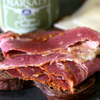
Dark Days Ticker — March 1-15
– Dark Days dinners at home: 8 out of 15
– Locavore dining-out: Range, Primavera, ubuntu, O Izakaya, Two, Conduit
– New recipes: Jamie’s stuffed potatoes, Hugh’s milk-braised pork, cauliflower steaks
– Old faves: corned beef & cabbage, egg drop soup, bean salad, Waltuck‘s chicken paprikás, grilled rib-eye
– Freezer fodder: golden veggie bisque, potstickers, chili verde enchiladas, oxtail ragu, bolognese sauce
New local items in the pantry:
– Straus Creamery cream-top milk (2% and whole)
– Marin Sun Farms point-cut brisket
– Fatted Calf pastrami (available at their Napa store only, alas!) and bierwurst
– Little‘s “all blue” potatoes
– Zuckerman’s asparagus
– Happy Girl Kitchen Co. prepared horseradish
– Andante butter
– 21st Amendment Oyster Stout (brewed with Hog Island oysters!)
– Carmel S&S Syrah (thanks, Lauren!)
– Bartholomew Park Cabernet
—-
* Edited to add: We removed the link to the Cook’s Illustrated recipe in July 2008 in protest of their bullying tactics.
beer, Dark Days challenge, holidays & occasions, locavore, meat, Napa & Sonoma, restaurants
12 Comments »




Posted by Anita on 03.14.08 7:07 AM
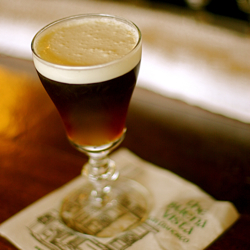 Happy St. Paddy’s Day!
Happy St. Paddy’s Day!
A wee bit early, you say? Nae, says I.
Although St. Patrick’s Day is usually observed on March 17, this year — with Easter coming so early — a bit of liturgical arcana has moved mountains. Because Catholic rules prohibit the celebration of saint’s feasts during Holy Week, the Church has actually moved St. Patrick’s Day to March 14. (For those of you keeping score at home, the last time this ecclesiastic clash occurred was 1940, and the next time will be 2160… so we’ve got a few years to plan.)
Most bishops are none too happy about drunken revelry during the holiest week of the year, and the clever ones are supporting the official shift by offering dispensation to their flocks, absolving them of the sin of carousing on a Lenten Friday, which is traditionally a day of abstinence. As you might expect, this once-in-most-lifetimes rescheduling has plenty of civic celebration-mavens in a tizzy — apparently, not everyone got the memo, and most cities (and nearly every bartender I’ve asked) will still be trotting out barrels of green beer on Monday.
But regardless of when you’re celebrating, there’s got to be a better glass to raise than watery, shamrock-colored beer. Please, I implore you: Grab yourself a snoot of Jameson (or Bushmills, if you’re of a Protestant sort), a pint of Guinness, a Black Velvet, or something else — anything else! — that reminds you of the Land of Saints and Scholars.
One of the best of your options, Irish Coffee was brought to America in the early 1950s by the then-owner of San Francisco’s Buena Vista Cafe, Jack Koeppler. Haunted by the drink he’d enjoyed at Shannon Airport before a seaplane flight home from the Emerald Isle, Koeppler and his friend Stanton Delaplane, a travel writer for the San Francisco Chronicle, tinkered and experimented for months to replicate the formula. Koeppler even made a return trip to Ireland — all in the name of “research”, of course — and brought back the official recipe from Joe Sheridan, the bartender who (by most accounts) invented the drink. Even today, enjoying an Irish Coffee at the Buena Vista remains one of the few legitimate reasons for a trip to Fisherman’s Wharf, an otherwise benighted stretch of The City best left to the socks-and-sandals set.
The cafe caused a tempest in a coffee cup last year when word leaked that the recipe had — gasp! — been altered. Although the current owner claims that cost was not a factor, the fact of the matter is that the Buena Vista abandoned their private-label whiskey in favor of off-the-shelf Tullamore Dew. The subtle change is lost on most customers, and the ol’ BV still turns out more than 2,000 Irish Coffees a day to windswept tourists as they toddle off the cable cars at the end of the line. I assure you that, Tullamore Dew or no, it tastes a heck of a lot better than green beer.





Irish Coffee
4oz fresh, hot coffee
2oz Irish whiskey
whipping cream
sugar cubes
Pour hot water into a footed coffee glass to bring it to temperature. Meanwhile, whip the cream lightly, just enough so that it will be able to float atop the drink, but not until peaks form. Pour the hot water out of the glass, and add two sugar cubes. Fill the glass about 3/4 full with hot coffee, and stir to dissolve the sugar cubes. Add the shot of whiskey, and top with the lightly whipped cream, pouring over a spoon to keep the layers distinct.
bar culture, coffee & tea, Drink of the Week, drinks, holidays & occasions
11 Comments »




Posted by Anita on 02.15.08 9:31 PM
 I know Valentine’s Day is officially over, but I’m not quite ready to leave the smooches and sweet-nothings behind quite yet. Like many of our friends, this year we’ve shifted our romantic celebration to the weekend. We’ve learned the hard way that being rushed through an overpriced set menu at a crowded restaurant, or scrambling to make a memorable meal at home on a weeknight, is no great recipe for romance.
I know Valentine’s Day is officially over, but I’m not quite ready to leave the smooches and sweet-nothings behind quite yet. Like many of our friends, this year we’ve shifted our romantic celebration to the weekend. We’ve learned the hard way that being rushed through an overpriced set menu at a crowded restaurant, or scrambling to make a memorable meal at home on a weeknight, is no great recipe for romance.
Although it’s not quite as bad as going to a bar on New Year’s Eve, trying to find a suitable sip for your sweetheart is perilous at best. I get a headache just thinking about the insipid sea of sickly-sweet Cosmos and cheap Champagne that’s floated out in poor Saint Valentine’s name each year. Bleh.
Even if you already celebrated your amorous occasion last night, you might fancy a taste of Royal Romance this weekend. According to CocktailDB, this faintly exotic drink won first prize in the British Empire Cocktail Competition of 1934. Curious about which particular liaison might have captured the creator’s fancy, I did a little digging.
It turns out that the alliance in question was quite the fashionable one. In September of 1934, England’s Prince George, the Duke of Kent, proposed to Princess Marina of Greece and Denmark. According to royal-watchers, the bride was “an accomplished linguist and skillful dressmaker … also widely renowned for her style and beauty.” The groom was no slouch, himself. “Cheerful, popular and handsome” Time magazine said of the Duke in reporting his betrothal, tactfully glossing over a social life that would exhaust Bertie Wooster, including a long history of affairs with glittering celebrities, socialites, and entertainers of both genders, and some dabbling in pharmaceutical recreation.
These two glamorous royals made headlines during their brief courtship, and had all London in their thrall in the run-up to the wedding — just the sort of hubbub that leads to the christening of a cocktail. Perhaps the Grand Mariner was a pun on the bride’s name, the gin a nod to Jolly Old England. Add some passion fruit juice for its allusions to ardent love, and grenadine for a bridal blush, and voilá: a cocktail worthy of the crown.

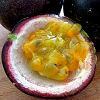



Royal Romance
1 1/2oz dry gin
3/4oz Grand Marnier
3/4oz passion fruit juice
grenadine
Shake the gin, Grand Marnier, and juice with ice and strain into a cocktail glass. Drop the grenadine from a bar spoon into the bottom of the glass as a garnish.
Drink of the Week, drinks, holidays & occasions, recipes
6 Comments »




Posted by Anita on 12.28.07 7:03 AM
 As 2007 slips away, our thoughts turn to cocktails we’d want to sip while curled up on the sofa with a good book or a fascinating companion. To my mind, the best drinks for the shortest nights mix spicy holiday flavors with a dash of new year’s sparkle.
As 2007 slips away, our thoughts turn to cocktails we’d want to sip while curled up on the sofa with a good book or a fascinating companion. To my mind, the best drinks for the shortest nights mix spicy holiday flavors with a dash of new year’s sparkle.
We wanted to pair these classic year-end tastes with seasonal citrus, given the incredible varieties gracing our farmers market. Initially, we tried blood-orange juice, elderflower liqueur, and Champagne, but we weren’t happy with the look — it screamed “Jello shot” rather than whispering “cocktail”. When we tried less garishly colored juices, our sparkler felt more like a complicated Mimosa than a cozy evening tipple.
Spying a small bottle of the Charbay Ruby Red grapefruit vodka in a pricey St. Helena liquor emporium, we decided to try a different route to the citrus belt. (Are you turning up your nose at flavored vodka? Don’t. These folks mean business: They use real fruit and old-world recipes. And they’re local. To us, anyway.) The vodka’s grapefruit-peel bitterness tempers the floral sweetness of the liqueur; the bubbly brightens the drink, while Fee’s whiskey-barrel bitters add a masculine depth.
Speaking of the Fee’s: If Santa didn’t leave you a bottle of these delectable drops in your stocking, you need to correct this error yourself. Yes, they’re worth the shocking premium over the cost of regular bitters, and you might have to break down and pay for shipping. If you have to go the mail-order route, you may as well buy a few bottles for friends. No, really… you can thank me later.
A finishing touch of orange bitters reinforces the drink’s citrus-spice scent, without adding any untoward sour or sweet notes. Of course, you can make this cocktail with any sparkling wine — a lovely trait during the time of year when half-finished bottles of bubbly seem to magically appear in fridges everywhere. But for that perfect flame-like glow, seek out a dryish rosé for your sparkler… and get ready to get cozy.





Firelight
1 oz St-Germain elderflower liqueur
1/2 oz grapefruit-infused vodka, homemade or Charbay Ruby Red
3 dashes Fee’s whiskey barrel bitters (or 2 dashes Angostura and 1 dash Peychaud’s)
—
2 oz rosé sparkling wine
1 to 2 dashes orange bitters (preferrably Regan’s)
In a mixing glass with ice, stir together the St-Germain, grapefruit vodka, and aromatic bitters. Strain into a chilled cocktail glass, and top with the bubbly and the orange bitters.
Drink of the Week, drinks, holidays & occasions, recipes
8 Comments »




Posted by Anita on 12.24.07 8:54 PM
 We hope your holiday — whichever one you celebrate — is brimming with cheer, and your new year will be filled wonderful things to eat and drink.
We hope your holiday — whichever one you celebrate — is brimming with cheer, and your new year will be filled wonderful things to eat and drink.
Thank you for stopping by, subscribing, and supporting us.
And thank you, too, for supporting Menu for Hope. With your generosity, we’ve raised more than $90,000 for the UN World Food Programme — more than half as much as last year.
We couldn’t have done it without you.
holidays & occasions, Menu for Hope
2 Comments »




Posted by Anita on 11.30.07 7:02 AM
 A few months ago, the New Yorker ran a ‘briefly noted’ blurb about Michael Lerner’s book Dry Manhattan: Prohibition in New York City. The review’s blasé tone must have dissuaded me from rushing out to buy a copy; instead, I patiently waited months for my chance to read our library’s single circulating print.
A few months ago, the New Yorker ran a ‘briefly noted’ blurb about Michael Lerner’s book Dry Manhattan: Prohibition in New York City. The review’s blasé tone must have dissuaded me from rushing out to buy a copy; instead, I patiently waited months for my chance to read our library’s single circulating print.
Had I known what a compelling read Dry Manhattan would be, I probably would have spent 20 bucks for the luxury of getting my hands on it sooner. True, it’s a bit scholarly, weighed down with inconvenient end-notes and a tendency toward expository repetition. But I can forgive the academic author’s shortcomings, given how entertaining the final story becomes, even when you know the ending.
Despite his geographic focus on New York City, Lerner illuminates the entire era by throwing a cosmopolitan light on the social changes that led both to Prohibition and its eventual Repeal. Although the book steers clear of drawing any overt parallels to current politics, readers who possess even a passing familiarity with modern-day prohibition movements — foie gras bans and the war on medical cannabis come to mind — will recognize plenty of eerie echoes from 80 years past. The story here makes a stark reminder of how a vocal, conservative, puritan minority swept away the freedoms of an entire country as their city-dwelling counterparts complacently boasted “it can never happen here”. Until it did… and it stayed that way for 13 long, dry years.
Honestly, it’s enough to send you straight to the bar in search of a sedative.
Perusing my library for appropriate Prohibition-era cocktails to salve my nerves, I stumbled upon a drink called the Ampersand in the Old Waldorf-Astoria Bar Book. How could I help but love a drink named after my favorite typographical glyph? (I suppose I just outed myself as a font geek. So be it.) Plus, it just sounds like a winner: Gin, brandy, sweet vermouth, plus a pair of orange-scented grace notes… What’s not to like?
But why “Ampersand”?
Although the compendium is rife with anecdotes — no great surprise, given that it was laid down by the hotel’s official historian — the origins of this particular drink’s name are lost to the mists of time. It’s possible that the typographical moniker’s a nod to Martini & Rossi, the still-popular Italian sweet vermouth, and one of the drink’s key ingredients.
Whatever the namer’s original intent, it seems particularly appropriate as cocktail bloggers around the world are celebrating both this month’s Mixology Monday & this year’s Repeal Day festivities next week. Wednesday evening, be sure to raise a glass of your favorite beverage in honor of those who fought the good fight in the 1930s, restoring the pursuit of mixological happiness to us all.





Ampersand
1 oz Old Tom gin (see note)
1 oz brandy
1 oz Italian sweet vermouth
2 dashes orange bitters
orange curaçao, to finish
In an ice-filled mixing glass, stir the gin, brandy, vermouth, and bitters until very cold. Strain into a chilled cocktail glass, then add two drops of curaçao.
Note: Old Tom was a sweetened gin of yore, a popular ingredient in many pre-Prohibition cocktail recipes. Although there are no ready sources for such a beast, fruit-derived gins such as G’vine are not bad stand-ins. Alternately, David Wondrich recommends slightly sweetened Plymouth or Junipero as acceptable substitutes; a drop or two of simple syrup seemed to do the trick in the Ampersand samples we tried. Given its lore, I suspect the original Old Tom gins were a fair deal harsher than anything on the shelves today, but we’re going for delicious approximations here, rather than slavish authenticity.
My neighbor Erik (proprietor of Underhill Lounge) was kind enough to let us sample from his personal stash of Death’s Door gin, a product that may be the closest modern Old Tom equivalent. Its flavor is noticeably sweet, a trait that the distillers assured Eric was intended rather than accidental. Alas, it’s not widely available outside the upper Midwest, but we didn’t find a drastic difference in mixed drinks made with Death’s Door compared with those made from sweetened dry gins.
bar culture, Drink of the Week, drinks, holidays & occasions, literary, Mixology Monday, other blogs, recipes
15 Comments »




Posted by Anita on 11.28.07 10:57 AM
 Come on, people, say it with me:
Come on, people, say it with me:
“Ugh, not turkey again!”
I know, I know — you’re probably as sick of reading about turkey as I am of eating it right about now. But, alas, that’s one of the perils of being the hostess: A house full of family and a fridge full of food seriously cuts into your blogging time. But now they’re all on their way — the relatives to the airport, the leftovers to the freezer or compost bin — and I’ve got a moment to get caught up.
(And I promise if you stick with me to the end, there’s a treat.)
I’d been noticing the steady disappearance of some of our autumn staples from the farmers market — bye-bye avocados, so long green beans — but at least when it came to our Thanksgiving feast, nearly everything came from within a 100-mile radius of home. As I wrote out my shopping list, I realized that I didn’t have to eliminate many favorites, and it occurred to me that Thanksgiving may be one of the few times of the year that most Americans are eating seasonally. With the exception of the cranberries in the relish, the bowl of buttered corn niblets (which I zipped and froze a few months ago), and a bit of commercial flour, everything on our plates came fresh from the farm, ranch, or dairy just a few days before they were eaten.
 Rather than list a page-long litany of producers and distances here, I decided to create a GoogleDocs spreadsheet. (Geek is the new black, they tell me.) I was so pleased that we inadvertently managed to do even better than usual for this one meal — our turkey was the only significant item that came from more than 100 miles away, although still very much inside our 200-mile protein foodshed. We also managed three other 99%-local meals this week: Lasagne served with beet and bleu cheese salad, pork chops with risotto and roasted cauliflower, and the ever-popular family tradition of a “(Not)-Spam and Eggs” holiday brunch.
Rather than list a page-long litany of producers and distances here, I decided to create a GoogleDocs spreadsheet. (Geek is the new black, they tell me.) I was so pleased that we inadvertently managed to do even better than usual for this one meal — our turkey was the only significant item that came from more than 100 miles away, although still very much inside our 200-mile protein foodshed. We also managed three other 99%-local meals this week: Lasagne served with beet and bleu cheese salad, pork chops with risotto and roasted cauliflower, and the ever-popular family tradition of a “(Not)-Spam and Eggs” holiday brunch.
—–
But enough about that; let’s skip ahead to dessert.
Longtime readers may recall my earlier confession that neither Cameron nor I enjoy eating squash. Amusingly enough, this even extends to pumpkin pie… or at least it did until a few years ago. In deference to holidays guests — for whom Thanksgiving would not be complete without a slice of crusted Curcubita custard — I grabbed a handy recipe and whipped it up.
The recipe’s unique twist was the use of pumpkin puree, rather than solid-pack squash, a tricky thing to find outside of health food stores in those days. (It’s since become ubiquitous at Whole Foods and the like, so you shouldn’t have to hunt.) My guests raved about the pie with such genuine eye-rolling pleasure that I reluctantly tried a small sliver. And wouldn’t you know it: This pie, for some reason, had no trace of the abhorred squashiness, just a luscious, pumpkin-y goodness.
I suspect that there’s something about the solid-pack processing that makes pumpkin especially gag-worthy, and that choosing puree keeps the texture light and the flavor fresh. This year, we steamed our own Sugar Pie pumpkins from Mariquita Farm, pureed the flesh, and used it in place of the canned variety. If anything, the result was even better than usual — a pumpkin pie that even squash-haters can love.
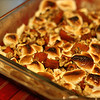
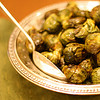

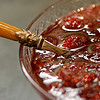

Classic Pumpkin Pie
single-crust pie dough, chilled 1 hour
(I use Martha’s pate brisee, replacing half of the butter with home-rendered leaf lard)
1/2 cup granulated sugar
1/2 cup loosely packed brown sugar
1-1/2 tsp. ground cinnamon
1 tsp. ground nutmeg
1/2 tsp. table salt
2 large eggs
4 large egg whites
1 pound pumpkin puree, or a 15 oz can (not solid pack)
1 cup cream
1 tsp vanilla extract
Position rack in lower third of oven, and preheat to 425° F.
In a large bowl, whisk sugar, brown sugar, cinnamon, nutmeg, and salt. Add eggs and egg whites, and whisk until well blended. Add pumpkin, whisking until smooth, then cream and vanilla; continue whisking until well combined.
On a lightly floured surface, roll out the dough into an 12-inch circle. Drape dough over rolling pin and fit into a 9-inch pie pan. Fold edges under and crimp. Place crust on a baking sheet.
Pour filling into crust, and bake for 10 minutes. Reduce oven temperature to 325° F, and continue to bake 55 to 75 minutes more, until center barely jiggles when the pan is tapped. If needed, cover the crust with foil strips or a shield to prevent over-browning.
Transfer pie to a wire rack, and cool. If not serving within the hour, loosely cover and refrigerate. (The crust suffers slightly, but the filling is even better when chilled.)
baking, dessert, holidays & occasions, locavore, recipes
6 Comments »




 I must be getting old, because I actually just said out loud: “Where has the year gone?” Really, people, can I get an amen here? Doesn’t it seem like 2008 has just screamed on by? (And yet, somehow, Election Day seems like it might never come.) I don’t want to get ahead of myself, but the holidays are really right around the corner, with Halloween just past and everyone’s favorite feast less than a month away. And today’s a holiday, too: Dia de los Muertos.
I must be getting old, because I actually just said out loud: “Where has the year gone?” Really, people, can I get an amen here? Doesn’t it seem like 2008 has just screamed on by? (And yet, somehow, Election Day seems like it might never come.) I don’t want to get ahead of myself, but the holidays are really right around the corner, with Halloween just past and everyone’s favorite feast less than a month away. And today’s a holiday, too: Dia de los Muertos.













































 We hope your holiday — whichever one you celebrate — is brimming with cheer, and your new year will be filled wonderful things to eat and drink.
We hope your holiday — whichever one you celebrate — is brimming with cheer, and your new year will be filled wonderful things to eat and drink.










